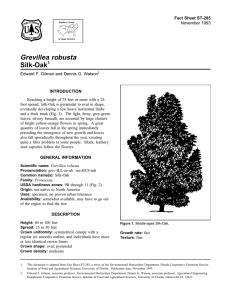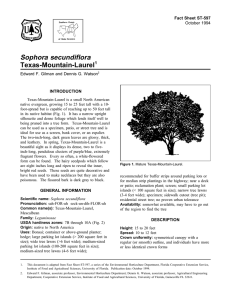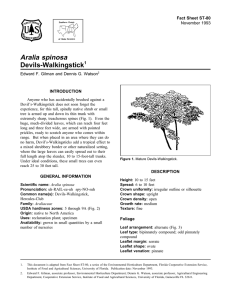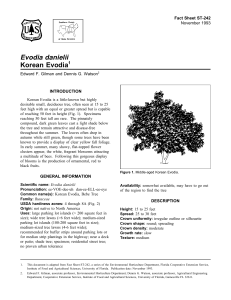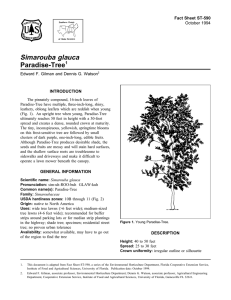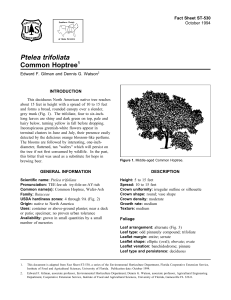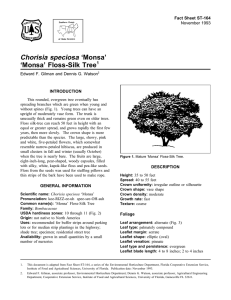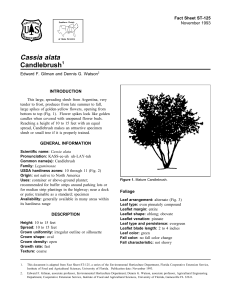Spathodea campanulata African Tulip-Tree Fact Sheet ST-600 1
advertisement
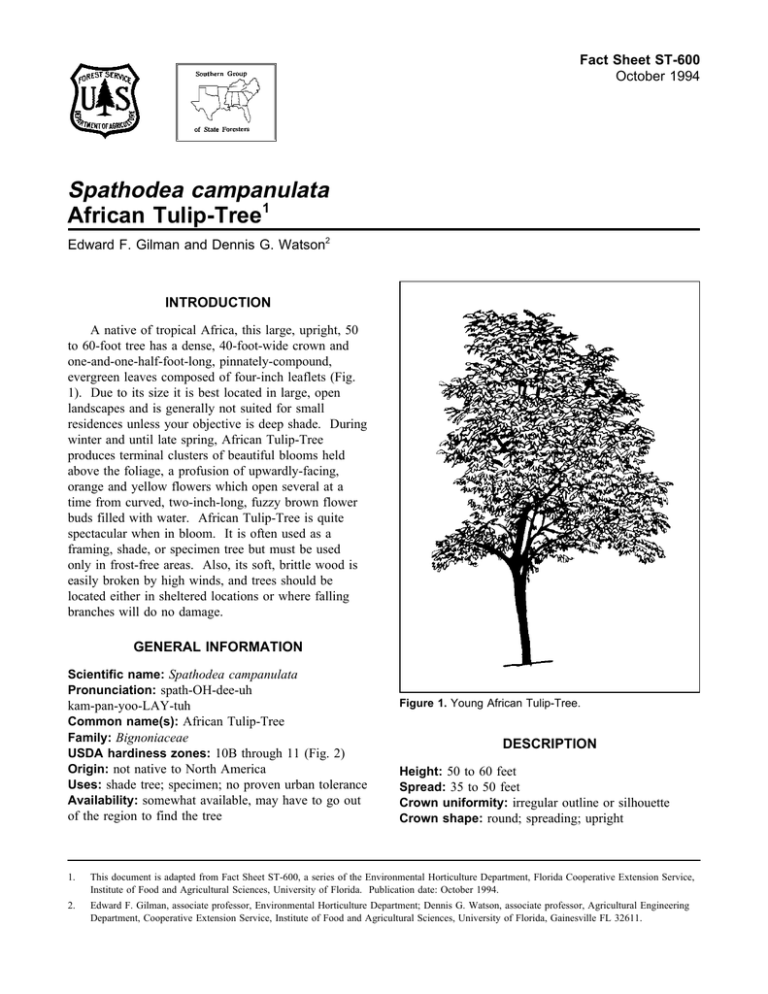
Fact Sheet ST-600 October 1994 Spathodea campanulata African Tulip-Tree1 Edward F. Gilman and Dennis G. Watson2 INTRODUCTION A native of tropical Africa, this large, upright, 50 to 60-foot tree has a dense, 40-foot-wide crown and one-and-one-half-foot-long, pinnately-compound, evergreen leaves composed of four-inch leaflets (Fig. 1). Due to its size it is best located in large, open landscapes and is generally not suited for small residences unless your objective is deep shade. During winter and until late spring, African Tulip-Tree produces terminal clusters of beautiful blooms held above the foliage, a profusion of upwardly-facing, orange and yellow flowers which open several at a time from curved, two-inch-long, fuzzy brown flower buds filled with water. African Tulip-Tree is quite spectacular when in bloom. It is often used as a framing, shade, or specimen tree but must be used only in frost-free areas. Also, its soft, brittle wood is easily broken by high winds, and trees should be located either in sheltered locations or where falling branches will do no damage. GENERAL INFORMATION Scientific name: Spathodea campanulata Pronunciation: spath-OH-dee-uh kam-pan-yoo-LAY-tuh Common name(s): African Tulip-Tree Family: Bignoniaceae USDA hardiness zones: 10B through 11 (Fig. 2) Origin: not native to North America Uses: shade tree; specimen; no proven urban tolerance Availability: somewhat available, may have to go out of the region to find the tree Figure 1. Young African Tulip-Tree. DESCRIPTION Height: 50 to 60 feet Spread: 35 to 50 feet Crown uniformity: irregular outline or silhouette Crown shape: round; spreading; upright 1. This document is adapted from Fact Sheet ST-600, a series of the Environmental Horticulture Department, Florida Cooperative Extension Service, Institute of Food and Agricultural Sciences, University of Florida. Publication date: October 1994. 2. Edward F. Gilman, associate professor, Environmental Horticulture Department; Dennis G. Watson, associate professor, Agricultural Engineering Department, Cooperative Extension Service, Institute of Food and Agricultural Sciences, University of Florida, Gainesville FL 32611. Spathodea campanulata -- African Tulip-Tree Page 2 Figure 2. Shaded area represents potential planting range. Crown density: moderate Growth rate: fast Texture: coarse Foliage Leaf arrangement: opposite/subopposite (Fig. 3) Leaf type: odd pinnately compound Leaflet margin: entire Leaflet shape: elliptic (oval); oblong Leaflet venation: pinnate Leaf type and persistence: broadleaf evergreen; evergreen Leaflet blade length: 2 to 4 inches Leaf color: green Fall color: no fall color change Fall characteristic: not showy Flower Flower color: orange; yellow Flower characteristics: spring flowering; very showy; winter flowering Fruit Fruit Fruit Fruit Fruit Fruit shape: elongated; pod length: 6 to 12 inches covering: dry or hard color: brown characteristics: does not attract wildlife; inconspicuous and not showy; fruit, twigs, or foliage cause significant litter Trunk and Branches Trunk/bark/branches: droop as the tree grows, and will require pruning for vehicular or pedestrian clearance beneath the canopy; not particularly showy; should be grown with a single leader; no thorns Pruning requirement: requires pruning to develop strong structure Breakage: susceptible to breakage either at the crotch due to poor collar formation, or the wood itself is weak and tends to break Current year twig color: brown Current year twig thickness: medium Spathodea campanulata -- African Tulip-Tree Page 3 Outstanding tree: not particularly outstanding Invasive potential: No entries found. Pest resistance: no pests are normally seen on the tree USE AND MANAGEMENT Eliminate major branches that will form embedded bark as early as possible. Save those that are oriented more horizontally, with stonger attachments to the trunk. Keep them from growing larger than about half the trunk diameter by periodic thinning. African Tulip-Trees will grow rapidly in full sun on any soil of reasonable drainage and fertility. Plants should be regularly watered until well-established and will then require little care. Propagation is by seed, softwood cuttings, or root suckers. Pests and Diseases No pests or diseases of major concern. Figure 3. Foliage of African Tulip-Tree. Culture Light requirement: tree grows in full sun Soil tolerances: clay; loam; sand; acidic; well-drained Drought tolerance: moderate Aerosol salt tolerance: low Other Roots: surface roots can lift sidewalks or interfere with mowing Winter interest: tree has winter interest due to unusual form, nice persistent fruits, showy winter trunk, or winter flowers

